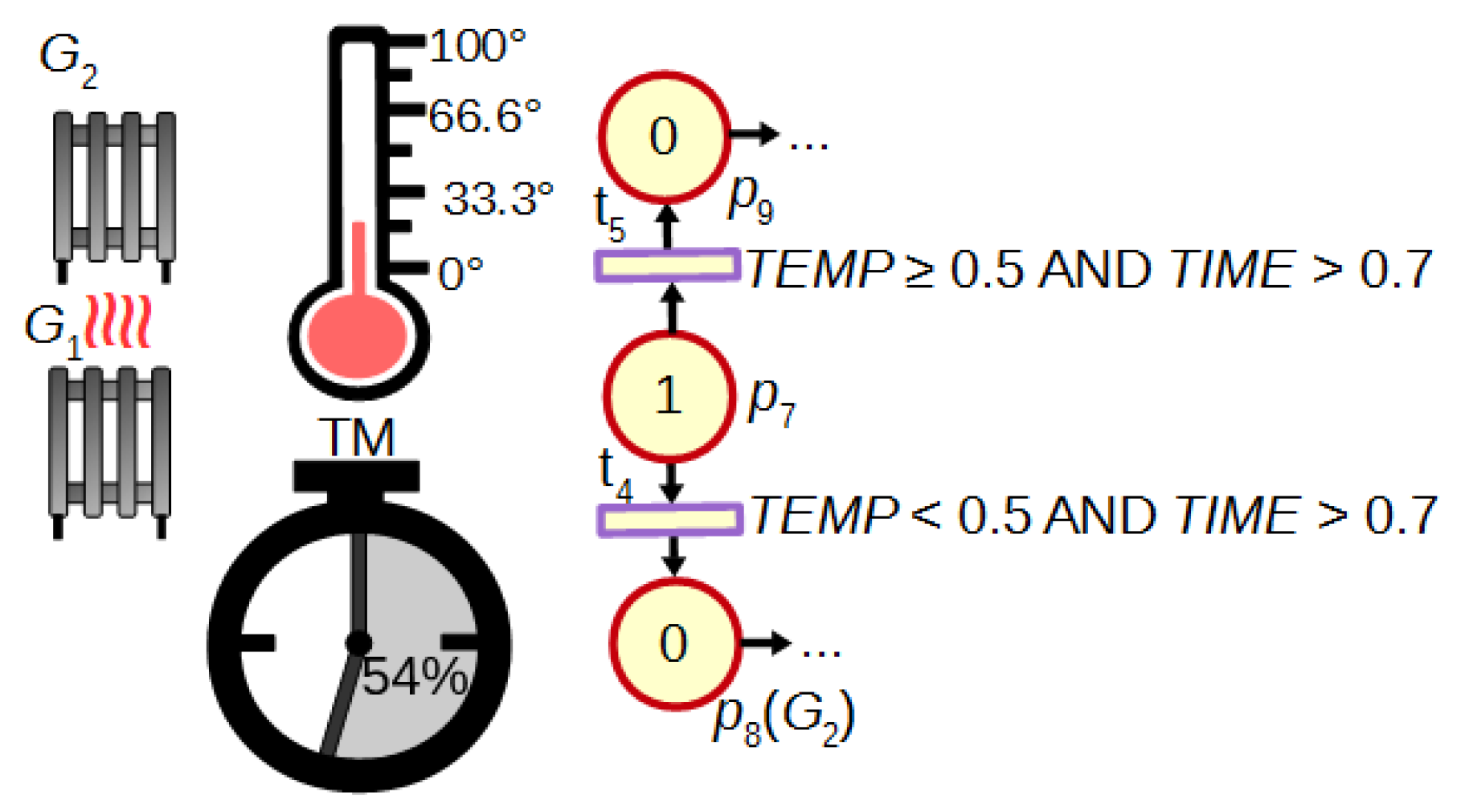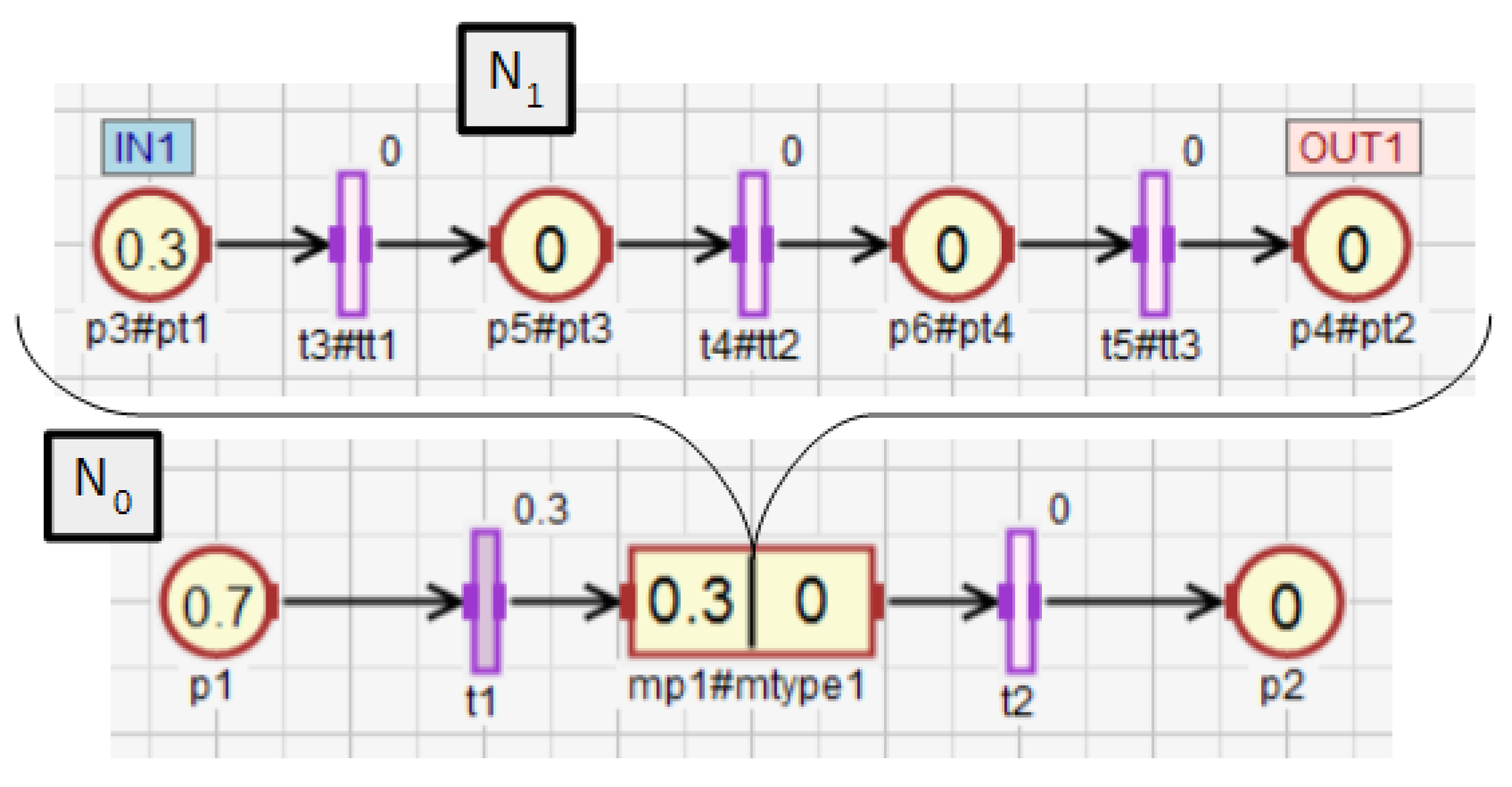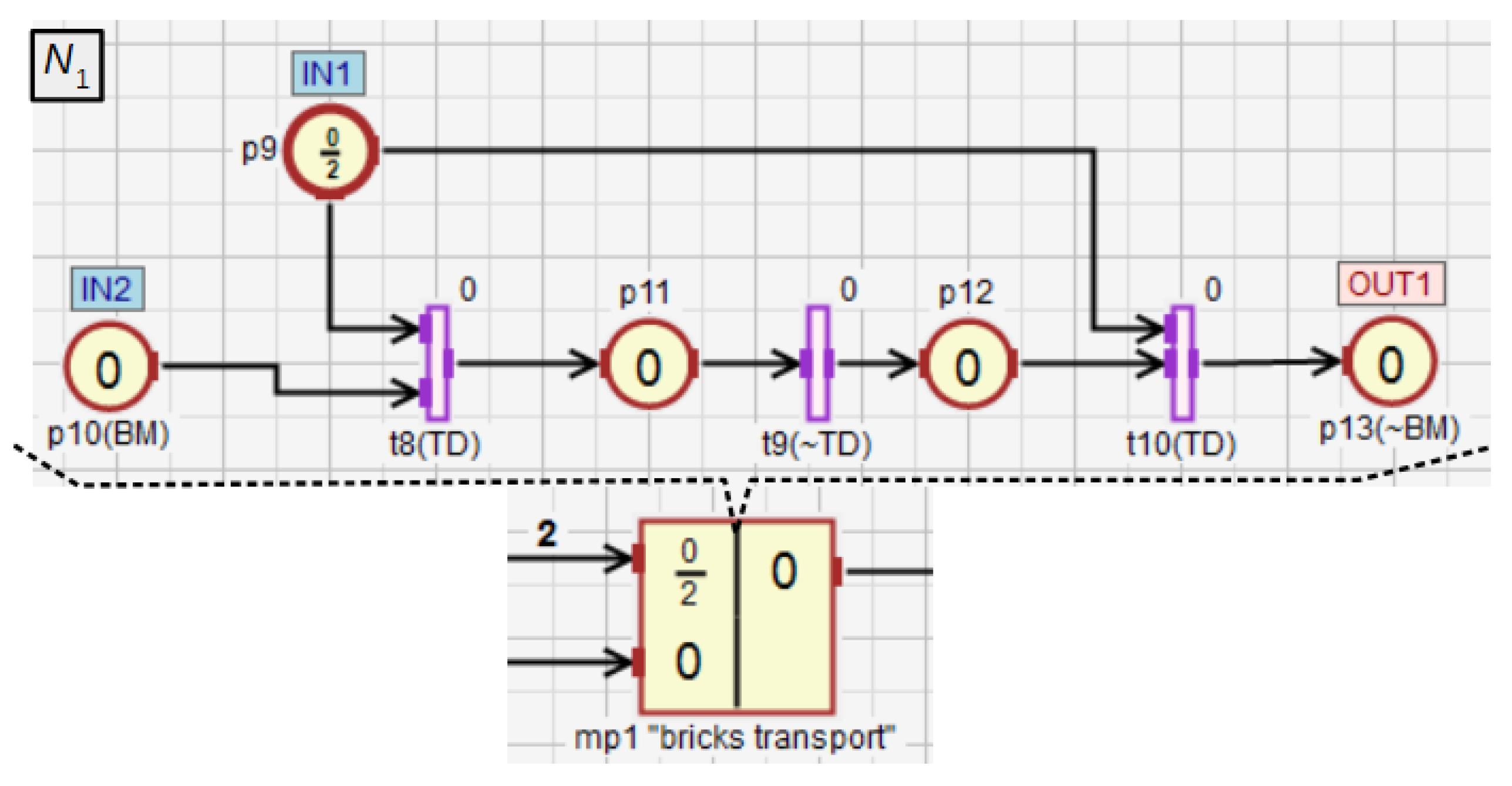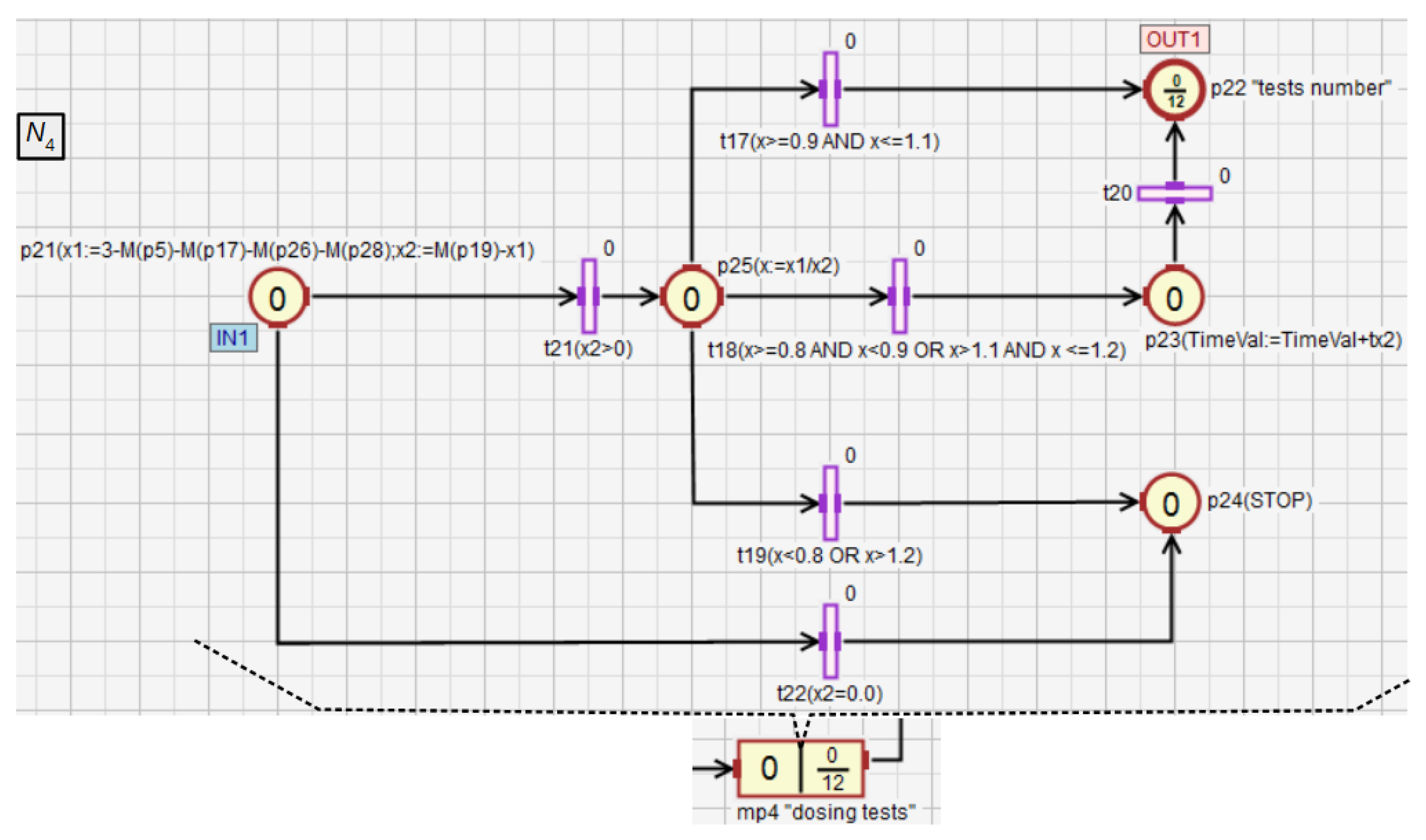Extended Hierarchical Fuzzy Interpreted Petri Net
Abstract
1. Introduction
1.1. Refinement of Places and Transitions
1.2. Reduction
1.3. Formal Description of the Hierarchical PNs
1.4. Hierarchical Nets in Industrial Standards
1.5. Methodology of Dealing with Complex Systems
1.6. Recent Studies
1.7. Paper Scope and Organization
- (a)
- Concept of a macroplace that can have several input, output and input-output places;
- (b)
- Functionality of macroplace instances;
- (c)
- Formal definition of HFIPN;
- (d)
- Concept and a definition of a hierarchy graph displaying a hierarchical structure and allowing a quick access to all subnets in an implementation version;
- (e)
- Formal algebraic representation of HFIPN;
- (f)
- Conversion of HFIPN to its flat version;
- (g)
- Formal way to sum any two subnets.
1.8. Comparison to Similar Solutions
2. The Formal Basis and the Concept of FIPN
3. New HFIPN Concept and Its Definitions
3.1. The Concept of HFIPN
3.2. Formal Description of HFIPN
3.3. The Hierarchy in HFIPN
3.4. The Algebraic Representation
- is the vector of the length , holding the current marking of places, where ;
- is the vector of the length , holding the new marking of places;
- is the vector of the length , in which the given coefficient is equal to one if it corresponds to the enabled transition by the marking in the subnet, where );
- is the vector of the length , in which the coefficient () describes the increment in the degree to which the condition corresponding to the transition () is satisfied;
- is the vector of the length , holding the places capacity.
3.5. HFIPN-SML Tool
- (a)
- the creation of a net graph,
- (b)
- the use of a hierarchical structure including macroplace instances,
- (c)
- the automatic code generation in Structured Text (ST) language for PLC controllers based on a non-hierarchical graph,
- (d)
- the hierarchy graph presentation,
- (e)
- displaying all vectors and matrices from algebraic representation,
- (f)
- automatic and step simulations of a net operation,
- (g)
- monitoring the operation of a program generated based on a non-hierarchical net.
4. Exemplary Application
5. Conclusions
- (a)
- Concept of a macroplace that can have several input, output and input-output places;
- (b)
- Functionality of a macroplace instance;
- (c)
- Formal definition of HFIPN;
- (d)
- Concept and a definition of a hierarchy graph displaying a hierarchical structure and allowing a quick access to all subnets in an implementation version;
- (e)
- Formal algebraic representation of HFIPN;
- (f)
- Conversion of HFIPN to its flat version;
- (g)
- Formal description of the combination of any two subnets in the hierarchical net.
Author Contributions
Funding
Institutional Review Board Statement
Informed Consent Statement
Data Availability Statement
Conflicts of Interest
References
- Valette, R. Analysis of Petri nets by stepwise refinements. J. Comput. Syst. Sci. 1979, 18, 35–46. [Google Scholar] [CrossRef]
- Suzuki, I.; Murata, T. A method for stepwise refinement and abstraction of Petri nets. J. Comput. Syst. Sci. 1983, 27, 51–76. [Google Scholar] [CrossRef]
- Vogler, W. Behaviour preserving refinements of Petri nets. In Graph-Theoretic Concepts in Computer Science; Tinhofer, G., Schmidt, G., Eds.; Number 246 in Lecture Notes in Computer Science, Springer: Berlin/Heidelberg, Germany, 1986; pp. 82–93. [Google Scholar] [CrossRef]
- Brauer, W.; Gold, R.; Vogler, W. A survey of behaviour and equivalence preserving refinements of Petri nets. In Advances in Petri Nets 1990; Rozenberg, G., Ed.; Lecture Notes in Computer Science; Springer: Berlin/Heidelberg, Germany, 1989; pp. 1–46. [Google Scholar] [CrossRef]
- Bernardinello, L.; De Cindio, F. A survey of basic net models and modular net classes. In Advances in Petri Nets 1992; Springer: London, UK, 1992; pp. 304–351. [Google Scholar]
- Van Der Aalst, W.M. Workflow verification: Finding control-flow errors using Petri-net-based techniques. In Business Process Management; Springer: Berlin/Heidelberg, Germany, 2000; pp. 161–183. [Google Scholar]
- Huang, H.; Jiao, L.; Cheung, T.Y. Property-Preserving Petri Net Process Algebra in Software Engineering; World Scientific: Singapore, 2012. [Google Scholar]
- Van Glabbeek, R.; Goltz, U. Refinement of actions in causality based models. In Stepwise Refinement of Distributed Systems Models, Formalisms, Correctness; Springer: Berlin/Heidelberg, Germany, 1989; pp. 267–300. [Google Scholar]
- Best, E.; Devillers, R.; Kiehn, A.; Pomello, L. Concurrent bisimulations in Petri nets. Acta Inform. 1991, 28, 231–264. [Google Scholar] [CrossRef]
- Vogler, W. Bisimulation and action refinement. Theor. Comput. Sci. 1993, 114, 173–200. [Google Scholar] [CrossRef][Green Version]
- Van Glabbeek, R.; Goltz, U. Refinement of actions and equivalence notions for concurrent systems. Acta Inform. 2001, 37, 229–327. [Google Scholar] [CrossRef]
- Jiao, L. Refining and verifying regular Petri nets. Int. J. Syst. Sci. 2008, 39, 17–27. [Google Scholar] [CrossRef]
- Hack, M. Analysis of Production Schemata by Petri Nets. Master’s Thesis, Massachusetts Institute of Technology, Cambridge, MA, USA, 1972. [Google Scholar]
- Lipton, R.J. Reduction: A method of proving properties of parallel programs. Commun. ACM 1975, 18, 717–721. [Google Scholar] [CrossRef]
- Kwong, Y.S. On reduction of asynchronous systems. Theor. Comput. Sci. 1977, 5, 25–50. [Google Scholar] [CrossRef][Green Version]
- Kowalk, W.; Valk, R. On reductions of parallel programs. In Automata, Languages and Programming; Maurer, H.A., Ed.; Number 71 in Lecture Notes in Computer Science; Springer: Berlin/Heidelberg, Germany, 1979; pp. 356–369. [Google Scholar] [CrossRef]
- Berthelot, G. Checking properties of nets using transformations. In European Workshop on Applications and Theory in Petri Nets; Springer: Berlin/Heidelberg, Germany, 1985; pp. 19–40. [Google Scholar]
- Berthelot, G. Transformations and decompositions of nets. In Petri Nets: Central Models and Their Properties; Brauer, W., Reisig, W., Rozenberg, G., Eds.; Number 254 in Lecture Notes in Computer Science; Springer: Berlin/Heidelberg, Germany, 1987; pp. 359–376. [Google Scholar] [CrossRef]
- Lee, K.H.; Favrel, J. Hierarchical reduction method for analysis and decomposition of Petri nets. IEEE Trans. Syst. Man Cybern. 1985, SMC-15, 272–280. [Google Scholar] [CrossRef]
- Lee, K.H.; Favrel, J.; Baptiste, P. Generalized Petri net reduction method. Syst. Man Cybern. IEEE Trans. 1987, 17, 297–303. [Google Scholar]
- Desel, J. Reduction and design of well-behaved concurrent systems. In CONCUR’90 Theories of Concurrency: Unification and Extension; Springer: Berlin/Heidelberg, Germany, 1990; pp. 166–181. [Google Scholar]
- Best, E.; Desel, J. Partial order behaviour and structure of Petri nets. Form. Asp. Comput. 1990, 2, 123–138. [Google Scholar] [CrossRef]
- Esparza, J. Reduction and synthesis of live and bounded free choice Petri nets. Inf. Comput. 1994, 114, 50–87. [Google Scholar] [CrossRef][Green Version]
- Desel, J.; Esparza, J. Free Choice Petri Nets; Cambridge University Press: Cambridge, UK, 2005; Volume 40. [Google Scholar]
- Jiao, L.; Cheung, T.Y.; Lu, W. Characterizing liveness of Petri nets in terms of siphons. In International Conference on Application and Theory of Petri Nets; Springer: Berlin/Heidelberg, Germany, 2002; pp. 203–216. [Google Scholar]
- Jiao, L.; Cheung, T.Y.; Lu, W. On liveness and boundedness of asymmetric choice nets. Theor. Comput. Sci. 2004, 311, 165–197. [Google Scholar] [CrossRef]
- Sloan, R.H.; Buy, U. Reduction rules for time Petri nets. Acta Inform. 1996, 33, 687–706. [Google Scholar] [CrossRef]
- Wang, J.; Deng, Y.; Zhou, M. Compositional time Petri nets and reduction rules. IEEE Trans. Syst. Man Cybern. Part B 2000, 30, 562–572. [Google Scholar] [CrossRef]
- Juan, E.; Tsai, J.; Murata, T.; Zhou, Y. Reduction methods for real-time systems using Delay Time Petri Nets. IEEE Trans. Softw. Eng. 2001, 27, 422–448. [Google Scholar] [CrossRef]
- Fehling, R. A concept of hierarchical Petri nets with building blocks. In Advances in Petri Nets 1993; Rozenberg, G., Ed.; Number 674 in Lecture Notes in Computer Science; Springer: Berlin/Heidelberg, Germany, 1991; pp. 148–168. [Google Scholar] [CrossRef]
- Jensen, K. Coloured Petri Nets: Basic Concepts, Analysis Methods and Practical Use; Springer Science & Business Media: Berlin/Heidelberg, Germany, 1997; Volume 1. [Google Scholar]
- Holvoet, T.; Verbaeten, P. Petri charts: An alternative technique for hierarchical net construction. In Proceedings of the 1995 IEEE International Conference on Systems, Man and Cybernetics, Intelligent Systems for the 21st Century, Vancouver, BC, Canada, 22–25 October 1995; Volume 3, pp. 2688–2693. [Google Scholar]
- He, X. A formal definition of hierarchical predicate transition nets. In Application and Theory of Petri Nets 1996; Billington, J., Reisig, W., Eds.; Number 1091 in Lecture Notes in Computer Science; Springer: Berlin/Heidelberg, Germany, 1996; pp. 212–229. [Google Scholar] [CrossRef]
- Andrzejewski, G. Hierarchical Petri nets for digital controller design. In Design of Embedded Control Systems; Springer: Berlin/Heidelberg, Germany, 2005; pp. 27–36. [Google Scholar]
- Pan, H.; Sun, J. Complex knowledge system modeling based on hierarchical fuzzy petri net. In Proceedings of the 2007 IEEE/WIC/ACM International Conferences on Web Intelligence and Intelligent Agent Technology-Workshops, Fremont, CA, USA, 2–5 November 2007; pp. 31–34. [Google Scholar]
- International Standard IEC 60848:2013: Grafcet Specification Language for Sequential Function Charts Approach; Technical Report; International Electrotechnical Commission: Geneva, Switzerland, 2013.
- International Standard IEC 61131-3: PROGRAMMABLE Controllers—Part 3: Programming Languages; International Standard; International Electrotechnical Commission: Geneva, Switzerland, 2013.
- David, R.; Alla, H. Discrete, Continuous, and Hybrid Petri Nets; Springer: Berlin/Heidelberg, Germany, 2010. [Google Scholar]
- Silva, M.; Valette, R. Petri nets and flexible manufacturing. In European Workshop on Applications and Theory in Petri Nets; Springer: Berlin/Heidelberg, Germany, 1988; pp. 374–417. [Google Scholar]
- Valavanis, K.P. On the hierarchical modeling analysis and simulation of flexible manufacturing systems with extended Petri nets. IEEE Trans. Syst. Man, Cybern. 1990, 20, 94–110. [Google Scholar] [CrossRef]
- Zhou, M.; DiCesare, F.; Desrochers, A.A. A hybrid methodology for synthesis of Petri net models for manufacturing systems. IEEE Trans. Robot. Autom. 1992, 8, 350–361. [Google Scholar] [CrossRef]
- Jeng, M.D.; DiCesare, F. Synthesis using resource control nets for modeling shared-resource systems. IEEE Trans. Robot. Autom. 1995, 11, 317–327. [Google Scholar] [CrossRef]
- Zhou, M. Modeling, analysis, simulation, scheduling, and control of semiconductor manufacturing systems: A Petri net approach. IEEE Trans. Semicond. Manuf. 1998, 11, 333–357. [Google Scholar] [CrossRef]
- Ye, J.; Zhou, M.; Li, Z.; Al-Ahmari, A. Structural decomposition and decentralized control of Petri nets. IEEE Trans. Syst. Man Cybern. Syst. 2017, 48, 1360–1369. [Google Scholar] [CrossRef]
- Wiśniewski, R.; Karatkevich, A.; Wojnakowski, M. Decomposition of distributed edge systems based on the Petri nets and linear algebra technique. J. Syst. Archit. 2019, 96, 20–31. [Google Scholar] [CrossRef]
- An, Y.; Wu, N.; Zhao, X.; Li, X.; Chen, P. Hierarchical colored petri nets for modeling and analysis of transit signal priority control systems. Appl. Sci. 2018, 8, 141. [Google Scholar] [CrossRef]
- Sicchar, J.R.; Da Costa, C.T.; Silva, J.R.; Oliveira, R.C.; Oliveira, W.D. A load-balance system design of microgrid cluster based on hierarchical petri nets. Energies 2018, 11, 3245. [Google Scholar] [CrossRef]
- Gozhyj, A.; Kalinina, I.; Gozhyj, V.; Vysotska, V. Web service interaction modeling with colored petri nets. In Proceedings of the 2019 10th IEEE International Conference on Intelligent Data Acquisition and Advanced Computing Systems: Technology and Applications (IDAACS), Metz, France, 18–21 September 2019; Volume 1, pp. 319–323. [Google Scholar]
- Li, W.; He, M.; Sun, Y.; Cao, Q. A novel layered fuzzy Petri nets modelling and reasoning method for process equipment failure risk assessment. J. Loss Prev. Process Ind. 2019, 62, 103953. [Google Scholar] [CrossRef]
- Yuan, C.; Liao, Y.; Kong, L.; Xiao, H. Fault diagnosis method of distribution network based on time sequence hierarchical fuzzy petri nets. Electr. Power Syst. Res. 2021, 191, 106870. [Google Scholar] [CrossRef]
- Majma, N.; Babamir, S.M.; Monadjemi, A. Runtime verification of pacemaker functionality using hierarchical fuzzy colored Petri-Nets. J. Med. Syst. 2017, 41, 1–21. [Google Scholar] [CrossRef]
- Padberg, J. Subtyping for hierarchical, reconfigurable Petri nets. arXiv 2018, arXiv:1802.04698. [Google Scholar]
- Figat, M.; Zieliński, C. Methodology of designing multi-agent robot control systems utilising hierarchical petri nets. In Proceedings of the 2019 International Conference on Robotics and Automation (ICRA), Paris, France, 31 May–4 June 2019; pp. 3363–3369. [Google Scholar]
- Silva, J.M.; Silva, J.R. A new hierarchical approach to requirement analysis of problems in automated planning. Eng. Appl. Artif. Intell. 2019, 81, 373–386. [Google Scholar] [CrossRef]
- Wisniewski, R.; Grobelna, I.; Karatkevich, A. Determinism in cyber-physical systems specified by interpreted petri nets. Sensors 2020, 20, 5565. [Google Scholar] [CrossRef]
- López, J.; Sánchez-Vilariño, P.; Sanz, R.; Paz, E. Implementing autonomous driving behaviors using a message driven petri net framework. Sensors 2020, 20, 449. [Google Scholar] [CrossRef] [PubMed]
- Proth, J.M.; Xie, X. Petri Nets: A Tool for Design and Management of Manufacturing Systems; John Wiley & Sons: Hoboken, NJ, USA, 1996; Volume 6. [Google Scholar]
- Uzam, M. The use of the Petri net reduction approach for an optimal deadlock prevention policy for flexible manufacturing systems. Int. J. Adv. Manuf. Technol. 2004, 23, 204–219. [Google Scholar] [CrossRef]
- Gniewek, L. Sequential control algorithm in the form of fuzzy interpreted Petri net. IEEE Trans. Syst. Man Cybern. Syst. 2013, 43, 451–459. [Google Scholar] [CrossRef]
- Gniewek, L. Coverability graph of fuzzy interpreted Petri net. IEEE Trans. Syst. Man Cybern. Syst. 2014, 44, 1272–1277. [Google Scholar] [CrossRef]
- Markiewicz, M.; Surdej, Ł.; Gniewek, L. Transformation of a fuzzy interpreted Petri net diagram into structured text code. In Proceedings of the 2016 21st International Conference on Methods and Models in Automation and Robotics (MMAR), Miedzyzdroje, Poland, 29 August–1 September 2016; pp. 94–99. [Google Scholar]
- Markiewicz, M.; Gniewek, L. A program model of fuzzy interpreted Petri net to control discrete event systems. Appl. Sci. 2017, 7, 422. [Google Scholar] [CrossRef]
- Hajduk, Z.; Wojtowicz, J. FPGA implementation of fuzzy interpreted Petri net. IEEE Access 2020, 8, 61442–61452. [Google Scholar] [CrossRef]
- Markiewicz, M.; Gniewek, L. Conception of hierarchical fuzzy interpreted Petri net. Stud. Inf. Control 2017, 26, 151–160. [Google Scholar] [CrossRef]
- Frey, G. Automatic implementation of Petri net based control algorithms on PLC. In Proceedings of the 2000 American Control Conference, ACC (IEEE Cat. No. 00CH36334), Chicago, IL, USA, 28–30 June 2000; Volume 4, pp. 2819–2823. [Google Scholar]
- Minas, M.; Frey, G. Visual PLC-programming using signal interpreted Petri nets. In Proceedings of the 2002 American Control Conference, Anchorage, USA, 8–10 May 2002; Volume 6, pp. 5019–5024. [Google Scholar]
- Klein, S.; Frey, G.; Minas, M. PLC programming with signal interpreted Petri nets. In International Conference on Application and Theory of Petri Nets; Springer: Berlin/Heidelberg, Germany, 2003; pp. 440–449. [Google Scholar]
- Frey, G. Hierarchical design of logic controllers using signal interpreted Petri nets. IFAC Proc. Vol. 2003, 36, 361–366. [Google Scholar] [CrossRef]
- Andreu, D.; Pascal, J.C.; Valette, R. Fuzzy Petri net-based programmable logic controller. IEEE Trans. Syst. Man Cybern. Part B 1997, 27, 952–961. [Google Scholar] [CrossRef]
- Gniewek, L.; Kluska, J. Hardware implementation of fuzzy Petri net as a controller. IEEE Trans. Syst. Man Cybern. Part B 2004, 34, 1315–1324. [Google Scholar] [CrossRef]
- Venkateswaran, P.; Bhat, J. Fuzzy Petri net algorithm for flexible manufacturing systems. ACSE J. 2006, 6, 1–5. [Google Scholar]
- Bauer, N.; Engell, S.; Huuck, R.; Lohmann, S.; Lukoschus, B.; Remelhe, M.; Stursberg, O. Verification of PLC programs given as sequential function charts. In Integration of Software Specification Techniques for Applications in Engineering; Springer: Berlin/Heidelberg, Germany, 2004; pp. 517–540. [Google Scholar]
- Roussel, J.M.; Lesage, J.J. Validation and verification of Grafcets using state machine. In IMACS-IEEE “CESA’96” July, Lille, 1996; pp. 758–764.
- Provost, J.; Roussel, J.M.; Faure, J.M. A formal semantics for Grafcet specifications. In Proceedings of the 2011 IEEE International Conference on Automation Science and Engineering, Trieste, Italy, 24–27 August 2011; pp. 488–494. [Google Scholar]
- Remelhe, M.; Lohmann, S.; Stursberg, O.; Engell, S.; Bauer, N. Algorithmic verification of logic controllers given as sequential function charts. In Proceedings of the 2004 IEEE International Conference on Robotics and Automation (IEEE Cat. No. 04CH37508), New Orleans, LA, USA, 26 April–1 May 2004; pp. 53–58. [Google Scholar]
- Lohmann, S.; Stursberg, O.; Engell, S. Comparison of event-triggered and cycle-driven models for verifying SFC programs. In Proceedings of the 2007 American Control Conference, New York, NY, USA, 9–13 July 2007; pp. 3606–3611. [Google Scholar]
- L’Her, D.; Le Parc, P.; Marcé, L. Proving sequential function chart programs using timed automata. Theor. Comput. Sci. 2001, 267, 141–155. [Google Scholar] [CrossRef]
- Stursberg, O.; Lohmann, S. Analysis of logic controllers by transformation of SFC into timed automata. In Proceedings of the 44th IEEE Conference on Decision and Control, Seville, Spain, 15–25 December 2005; pp. 7720–7725. [Google Scholar]
- Wightkin, N.; Buy, U.; Darabi, H. Formal modeling of sequential function charts with time Petri nets. IEEE Trans. Control Syst. Technol. 2010, 19, 455–464. [Google Scholar] [CrossRef]
- Sogbohossou, M.; Vianou, A. Formal modeling of Grafcets with time Petri nets. IEEE Trans. Control Syst. Technol. 2015, 23, 1978–1985. [Google Scholar] [CrossRef]
- Peng, S.; Zhou, M. Design and analysis of sequential function charts using sensor-based stage Petri nets. In Proceedings of the SMC’03 Conference Proceedings, 2003 IEEE International Conference on Systems, Man and Cybernetics, Conference Theme-System Security and Assurance (Cat. No. 03CH37483), Washington, DC, USA, 5–8 October 2003; Volume 5, pp. 4748–4753. [Google Scholar]
- Fujino, K.; Imafuku, K.; Yuh, Y.; Hirokazu, N. Design and verification of the SFC program for sequential control. Comput. Chem. Eng. 2000, 24, 303–308. [Google Scholar] [CrossRef]
- Schumacher, F.; Fay, A. Transforming time constraints of a Grafcet graph into a suitable Petri net formalism. In Proceedings of the 2013 IEEE International Conference on Industrial Technology (ICIT), Cape Town, South Africa, 25–28 February 2013; pp. 210–218. [Google Scholar]
















| HFIPN | GrafcetSFC | SIPN | Other Fuzzy PNs | |
|---|---|---|---|---|
| hierarchy/modularization | ✓ | ✓ | ✓ | ✗ |
| analogue signals | ✓ | ✗ | ✗ | ✓ |
| software tool support | ✓ | ✓ | ✓ | ✗ |
| modeling of resources using a net structure | ✓ | ✗ | ✗ | ✗ |
| automatic executable code generation | ✓ /✗ | ✓ | ✓ | ✗ |
| automatic investigation of properties | ✓ /✗ | ✓ /✗ | ✓ | ✗ |
Publisher’s Note: MDPI stays neutral with regard to jurisdictional claims in published maps and institutional affiliations. |
© 2021 by the authors. Licensee MDPI, Basel, Switzerland. This article is an open access article distributed under the terms and conditions of the Creative Commons Attribution (CC BY) license (https://creativecommons.org/licenses/by/4.0/).
Share and Cite
Markiewicz, M.; Gniewek, L.; Warchoł, D. Extended Hierarchical Fuzzy Interpreted Petri Net. Sensors 2021, 21, 8433. https://doi.org/10.3390/s21248433
Markiewicz M, Gniewek L, Warchoł D. Extended Hierarchical Fuzzy Interpreted Petri Net. Sensors. 2021; 21(24):8433. https://doi.org/10.3390/s21248433
Chicago/Turabian StyleMarkiewicz, Michał, Lesław Gniewek, and Dawid Warchoł. 2021. "Extended Hierarchical Fuzzy Interpreted Petri Net" Sensors 21, no. 24: 8433. https://doi.org/10.3390/s21248433
APA StyleMarkiewicz, M., Gniewek, L., & Warchoł, D. (2021). Extended Hierarchical Fuzzy Interpreted Petri Net. Sensors, 21(24), 8433. https://doi.org/10.3390/s21248433







